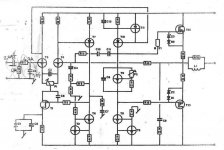HI!
I have a standard 100W MOSFET power amp and need to raise the input sensitivity.
I'm using it for my guitar rack and my preamp can only send out an output swing of 250mV.
The Power amp needs 750mv to give 100w.
What resistors do I need to change to raise input sensitivity?
Best,
Peter
I have a standard 100W MOSFET power amp and need to raise the input sensitivity.
I'm using it for my guitar rack and my preamp can only send out an output swing of 250mV.
The Power amp needs 750mv to give 100w.
What resistors do I need to change to raise input sensitivity?
Best,
Peter
Attachments
I don't know how to modify that sort of amp for more gain, but i suppose you could always put an opamp circuit with fixed x3 or x4 gain. Would need an op amp, and some circuitry to get voltage low enough for it .
I do not fully understand the feedback network, but my best guess is: try increasing R18 and the 47kohm resistor at the input by a factor of about three, readjust P1 for minimum DC offset at the output and test it thoroughly before connecting any expensive loudspeaker.
You simply need to triple the value of R18.
(Just add I don't fully understand the feedback network as R6
appears to be adding some local feedback, but I'm still confident
the above is all you need to do)
Do not change R2.
It will be noisier, have more distortion and have more offset.
Stability into loads will be improved as your gain margin will increase.
Theoretically you could reduce the compensation but I do not recommend this.
(And I'm not exactly sure how it is compensated)
🙂 sreten.
(Just add I don't fully understand the feedback network as R6
appears to be adding some local feedback, but I'm still confident
the above is all you need to do)
Do not change R2.
It will be noisier, have more distortion and have more offset.
Stability into loads will be improved as your gain margin will increase.
Theoretically you could reduce the compensation but I do not recommend this.
(And I'm not exactly sure how it is compensated)
🙂 sreten.
I assumed, maybe incorrectly, that R18 and R2 have roughly the same value, such that the voltage drop the DC base current causes across R18 is roughly compensated for by the voltage drop across R2.
If R18 has a value which is not close to 47kohm, I agree with sreten about the offset. In that case, it makes no sense to change R2; just change R18, readjust P1 for minimum offset and test thoroughly.
If R18 has a value which is not close to 47kohm, I agree with sreten about the offset. In that case, it makes no sense to change R2; just change R18, readjust P1 for minimum offset and test thoroughly.
Hi Marcel
You sound right, but 150K seemed too high an input impedance to me at first glance.
As R2 at AC will be swamped by the driving source AC impedance your reasoning seems perfectly sound to me.
So if R18 is / near 47K then replace R18 and R2 with 150K.
This will help with offset, but the higher gain amplifier will have worse offset drift than the lower gain version.
🙂 sreten.
You sound right, but 150K seemed too high an input impedance to me at first glance.
As R2 at AC will be swamped by the driving source AC impedance your reasoning seems perfectly sound to me.
So if R18 is / near 47K then replace R18 and R2 with 150K.
This will help with offset, but the higher gain amplifier will have worse offset drift than the lower gain version.
🙂 sreten.
- Status
- Not open for further replies.
